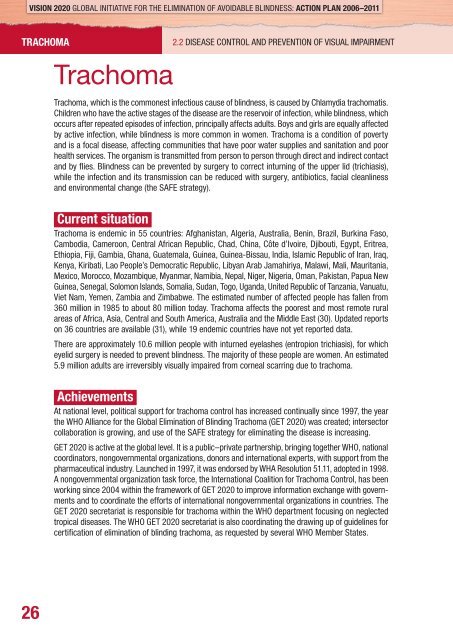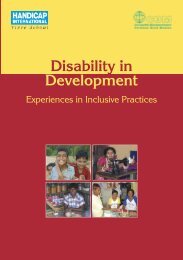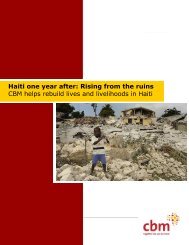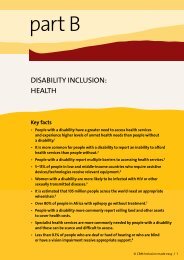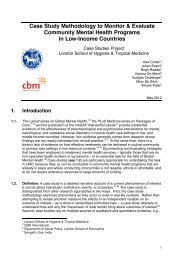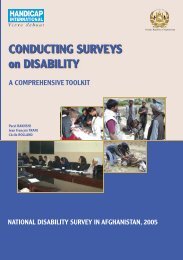Vision 2020 - World Health Organization
Vision 2020 - World Health Organization
Vision 2020 - World Health Organization
You also want an ePaper? Increase the reach of your titles
YUMPU automatically turns print PDFs into web optimized ePapers that Google loves.
VISION <strong>2020</strong> GLOBAL INITIATIVE FOR THE ELIMINATION OF AVOIDABLE BLINDNESS: ACTION PLAN 2006–2011<br />
TRACHOMA<br />
2.2 DISEASE CONTROL AND PREVENTION OF VISUAL IMPAIRMENT<br />
Trachoma<br />
Trachoma, which is the commonest infectious cause of blindness, is caused by Chlamydia trachomatis.<br />
Children who have the active stages of the disease are the reservoir of infection, while blindness, which<br />
occurs after repeated episodes of infection, principally affects adults. Boys and girls are equally affected<br />
by active infection, while blindness is more common in women. Trachoma is a condition of poverty<br />
and is a focal disease, affecting communities that have poor water supplies and sanitation and poor<br />
health services. The organism is transmitted from person to person through direct and indirect contact<br />
and by fl ies. Blindness can be prevented by surgery to correct inturning of the upper lid (trichiasis),<br />
while the infection and its transmission can be reduced with surgery, antibiotics, facial cleanliness<br />
and environmental change (the SAFE strategy).<br />
Current situation<br />
Trachoma is endemic in 55 countries: Afghanistan, Algeria, Australia, Benin, Brazil, Burkina Faso,<br />
Cambodia, Cameroon, Central African Republic, Chad, China, Côte d’Ivoire, Djibouti, Egypt, Eritrea,<br />
Ethiopia, Fiji, Gambia, Ghana, Guatemala, Guinea, Guinea-Bissau, India, Islamic Republic of Iran, Iraq,<br />
Kenya, Kiribati, Lao People’s Democratic Republic, Libyan Arab Jamahiriya, Malawi, Mali, Mauritania,<br />
Mexico, Morocco, Mozambique, Myanmar, Namibia, Nepal, Niger, Nigeria, Oman, Pakistan, Papua New<br />
Guinea, Senegal, Solomon Islands, Somalia, Sudan, Togo, Uganda, United Republic of Tanzania, Vanuatu,<br />
Viet Nam, Yemen, Zambia and Zimbabwe. The estimated number of affected people has fallen from<br />
360 million in 1985 to about 80 million today. Trachoma affects the poorest and most remote rural<br />
areas of Africa, Asia, Central and South America, Australia and the Middle East (30). Updated reports<br />
on 36 countries are available (31), while 19 endemic countries have not yet reported data.<br />
There are approximately 10.6 million people with inturned eyelashes (entropion trichiasis), for which<br />
eyelid surgery is needed to prevent blindness. The majority of these people are women. An estimated<br />
5.9 million adults are irreversibly visually impaired from corneal scarring due to trachoma.<br />
Achievements<br />
At national level, political support for trachoma control has increased continually since 1997, the year<br />
the WHO Alliance for the Global Elimination of Blinding Trachoma (GET <strong>2020</strong>) was created; intersector<br />
collaboration is growing, and use of the SAFE strategy for eliminating the disease is increasing.<br />
GET <strong>2020</strong> is active at the global level. It is a public–private partnership, bringing together WHO, national<br />
coordinators, nongovernmental organizations, donors and international experts, with support from the<br />
pharmaceutical industry. Launched in 1997, it was endorsed by WHA Resolution 51.11, adopted in 1998.<br />
A nongovernmental organization task force, the International Coalition for Trachoma Control, has been<br />
working since 2004 within the framework of GET <strong>2020</strong> to improve information exchange with governments<br />
and to coordinate the efforts of international nongovernmental organizations in countries. The<br />
GET <strong>2020</strong> secretariat is responsible for trachoma within the WHO department focusing on neglected<br />
tropical diseases. The WHO GET <strong>2020</strong> secretariat is also coordinating the drawing up of guidelines for<br />
certifi cation of elimination of blinding trachoma, as requested by several WHO Member States.<br />
26


